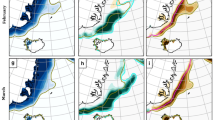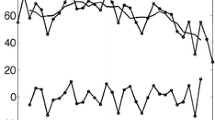Abstract
The role of winter sea-ice in the Labrador Sea as a precursor for precipitation anomalies over southeastern North America and Western Europe in the following spring is investigated. In general terms, as the sea ice increases, the precipitation also increases. In more detail, however, analyses indicate that both the winter sea-ice and the sea surface temperature (SST) anomalies related to increases in winter sea-ice in the Labrador Sea can persist into the following spring. These features play a forcing role in the spring atmosphere, which may be the physical mechanism behind the observational relationship between the winter sea-ice and spring precipitation anomalies. The oceanic forcings in spring include Arctic sea-ice anomalies and SST anomalies in the tropical Pacific and high-latitude North Atlantic. Multi-model Coupled Model Intercomparison Project Phase 5 and Atmospheric Model Intercomparison Project simulation results show that the atmospheric circulation response to the combination of sea-ice and SST is similar to that observed, which suggests that the oceanic forcings are indeed the physical reason for the enhanced spring precipitation. Sensitivity experiments conducted using an atmospheric general circulation model indicate that the increases in precipitation over southeastern North America are mainly attributable to the effect of the SST anomalies, while the increases overWestern Europe are mainly due to the sea-ice anomalies. Although model simulations reveal that the SST anomalies play the primary role in the precipitation anomalies over southeastern North America, the observational statistical analyses indicate that the area of sea-ice in the Labrador Sea seems to be the precursor that best predicts the spring precipitation anomaly.
摘要
当冬季拉布拉多海海冰增加时, 北美东南部和欧洲西部的春季降水会增加. 因此, 冬季拉布拉多海海冰可以作为春季降水的一个预测因子. 进一步的分析表明, 海冰异常和与之同时出现的海温异常都能够持续至春季, 并对春季大气环流产生影响, 从而导致降水异常. 这是冬季海冰和春季降水产生联系的主要原因, CMIP5的AMIP试验也证明了这一点. 在这一联系中, 海冰和海温各自起到何种作用呢? 大气环流模式敏感性试验表明, 北美东南部的降水主要是由海温异常造成; 欧洲西部的降水主要由海冰异常造成. 值得注意的是, 尽管模式试验表明海温异常主要造成北美东南部的降水异常, 但是冬季的拉布拉多海海冰异常是最好的统计预测因子, 因为我们无法从观测中分离出上述海温异常信号.
Similar content being viewed by others
References
Alexander, M. A., U. S. Bhatt, J. E. Walsh, M. S. Timlin, J. S. Miller, and J. D. Scott, 2004: The atmospheric response to realistic Arctic sea ice anomalies in an AGCM during winter. J. Climate, 17, 890–905, https://doi.org/10.1175/1520-0442(2004)017<0890:TARTRA>2.0.CO;2.
Cavalieri, D. J., C. L. Parkinson, P. Gloersen, and H. Zwally, 1996: Sea ice concentrations from Nimbus-7 SMMR and DMSP SSM/I-SSMIS passive microwave data, version 1. November 1979–2014, Tech. Rep., NASA Natl. Snow and Ice Data Cent. Distrib. Active Archive Cent., Boulder, Colo.
Conil, S., and Z. X. Li, 2005: Linearity of the atmospheric response to North Atlantic SST and sea ice anomalies. J. Climate, 18, 1986–2003, https://doi.org/10.1175/JCLI3388.1.
Dee, D. P., and Coauthors, 2011: The ERA-Interim reanalysis: Configuration and performance of the data assimilation system. Quart. J. Roy. Meteor. Soc., 137, 553–597, https://doi.org/10.1002/qj.828.
Deser, C., J. E. Walsh, and M. S. Timlin, 2000: Arctic sea ice variability in the context of recent atmospheric circulation trends. J. Climate, 13, 617–633, https://doi.org/10.1175/1520-0442(2000)013<0617:ASIVIT>2.0.CO;2.
Deser C, G. Magnusdottir, R. Saravanan, and A. Phillips, 2004: The effects of North Atlantic SST and sea ice anomalies on the winter circulation in CCM3. Part II: direct and indirect components of the response. J. Climate, 17, 877–889, https://doi.org/10.1175/1520-0442(2004)017<0877:TEONAS>2.0.CO;2.
Duchon, C. E., 1979: Lanczos filtering in one and two dimensions. J. Appl. Meteorol., 18, 1016–1022, https://doi.org/10.1175/1520-0450(1979)018<1016:LFIOAT>2.0.CO;2.
Frankignoul, C., N. Sennéchael, and P. Cauchy, 2014: Observed atmospheric response to cold season sea ice variability in the Arctic. J. Climate, 27, 1243–1254, https://doi.org/10.1175/JCLI-D-13-00189.1.
Guo, D., Y. Gao, I. Bethke, D. Gong, M. Johannessen, and H. J. Wang, 2014: Mechanism on how the spring Arctic sea ice impacts the East Asian summer monsoon. Theor. Appl. Climatol., 115, 107–119, https://doi.org/10.1007/s00704-013-0872-6.
Honda, M., J. Inoue, and S. Yamane, 2009: Influence of low Arctic sea-ice minima on anomalously cold Eurasian winters. Geophys. Res. Lett., 36, L08707, https://doi.org/10.1029/2008GL037079.
Han, Z., F. F. Luo, and J. H. Wan, 2016a: The observational influence of the North Atlantic SST tripole on the early spring atmospheric circulation. Geophys. Res. Lett., 43, 2998–3003, https://doi.org/10.1002/2016GL068099.
Han, Z., S. L. Li, J. P. Liu, Y. Q. Gao, and P. Zhao, 2016b: Linear additive impacts of arctic sea ice reduction and La Ni˜na on northern hemispheric winter climate. J. Climate, 29, https://doi.org/10.1175/JCLI-D-15-0416.1.
Hawcroft, M. K., L. C. Shaffrey, K. I. Hodges, and H. F. Dacre, 2012: How much Northern Hemisphere precipitation is associated with extratropical cyclones? Geophys. Res. Lett., 39, https://doi.org/10.1029/2012GL053866.
Huang, S. L., X. Q. Yang, and Q. Xie, 1992: The effects of the Arctic sea ice on the variations of atmospheric circulation and climate. Acta Meteorologica Sinica, 6, 1–14.
Kvamstø, N. G., P. Skeie, and D. B. Stephenson, 2004: Impact of Labrador Sea-ice extent on the North Atlantic Oscillation. Int. J. Climatol., 24, 603–612, https://doi.org/10.1002/joc.1015.
Li, F., and H. J. Wang, 2013: Relationship between Bering Sea ice cover and East Asian winter monsoon year-to-year variations. Adv. Atmos. Sci., 30, 48–56, https://doi.org/10.1007/s00376-012-2071-2.
Liu, J. P., J. A. Curry, H. Wang, M. Song, and R. M. Horton, 2012: Impact of declining Arctic sea ice on winter snowfall. Proceedings of the National Academy of Sciences of the Unites States of America., 109, 4074–4079, https://doi.org/10.1073/pnas.V1114910109.
Magnusdottir, G., C. Deser, and R. Saravanan, 2004: The effects of North Atlantic SST and sea ice anomalies on the winter circulation in CCM3. Part I: Main features and storm track characteristic of the response. J. Climate, 17, 857–876, https://doi.org/10.1175/1520-0442(2004)017<0877:TEONAS>2.0.CO;2.
Mori, M., M. Watanabe, H. Shiogama, J. Inoue, and M. Kimoto, 2014: Robust Arctic sea-ice influence on the frequent Eurasian cold winters in past decades. Nature Geoscience, 7, 869–873, https://doi.org/10.1038/ngeo2277.
Overland, J. E., J. A. Francis, R. Hall, E. Hanna, S.-J. Kim, and T. Vihma, 2015: The melting Arctic and midlatitude weather patterns: Are they connected? J. Climate, 28, 7917–7932, https://doi.org/10.1175/JCLI-D-14-00822.1.
Rayner, N. A., D. E. Parker, E. B. Horton, C. K. Folland, L. V. Alexander, D. P. Powell, E. C. Kent, and A. Kaplan, 2003: Global analyses of sea surface temperature, sea ice, and night marine air temperature since the late nineteenth century. J. Geophys. Res., 108, 4407–4443, https://doi.org/10.1029/2002JD002670.
Roeckner, E., and Coauthors, 2003: The atmospheric general circulation model ECHAM5. Part I: Model description. Max Planck Institute for Meteorology Rep, No. 349, 127 pp.
Roeckner, E., and Coauthors, 2006: Sensitivity of simulated climate to horizontal and vertical resolution in the ECHAM5 atmosphere model. J. Climate, 19, 3771–3791, https://doi.org/10.1175/JCLI3824.1.
Schneider, U., and Coauthors, 2011: GPCC full data reanalysis version 6.0 at 1.0°: Monthly land-surface precipitation from rain-gauges built on GTS-based and historic data. https://doi.org/10.5676/DWDGPCC/FD M V6 100. [Available online from https://rda.ucar.edu/datasets/ds496.0/]
Strong, C., and G. Magnusdottir, 2011: Dependence of NAO variability on coupling with sea ice. Climate Dyn., 36, 1681–1689, https://doi.org/10.1007/s00382-010-0752-z.
Walsh, J. E., 2014: Intensified warming of the Arctic: Causes and impacts on middle latitudes. Global and Planetary Change, 117, 52–63, https://doi.org/10.1016/j.gloplacha.2014.03.003.
Wen, N., Z. Y. Liu, Q. Y. Liu, and C. Frankignoul, 2005: Observations of SST, heat flux and north Atlantic ocean–atmosphere interaction. Geophys. Res. Lett., 32, 348–362, https://doi.org/10.1029/2005GL024871.
World Meteorological Organization, 2012: WMO Statement on the Status of the Global Climate in 2011. WMO-No. 1085.World Meteorological Organization.
Wu, B. Y., J. Z. Su, and R. H. Zhang, 2011: Effects of autumnwinter Arctic sea ice on winter Siberian High. Chinese Science Bulletin, 56, 3220–3228, https://doi.org/10.1007/s11434-011-4696-4.
Wu, B. Y., R. H. Zhang, R. D’Arrigo, and J. Z. Su, 2013: On the relationship between winter sea ice and summer atmospheric circulation over Eurasia. J. Climate, 26, 5523–5536, https://doi.org/10.1175/JCLI-D-12-00524.1.
Wu, B. Y., J. Z. Su, and R. D’Arrigo, 2015: Patterns of Asian winter climate variability and links to Arctic sea ice. J. Climate, 28, 6841–6858, https://doi.org/10.1175/JCLI-D-14-00274.1.
Wu, B. Y., K. Yang, and J. A. Francis, 2016: Summer Arctic dipole wind pattern affects the winter Siberian High. Int. J. Climatol., 36, 4187–4201, https://doi.org/10.1002/joc.4623.
Wu, Q. G., and X. D. Zhang, 2010: Observed forcing-feedback processes between Northern Hemisphere atmospheric circulation and Arctic sea ice coverage. J. Geophys. Res., 115, D14119, https://doi.org/10.1029/2009JD013574.
Xie, P. P., and P. A. Arkin, 1997: Global precipitation: A 17-year monthly analysis based on gauge observations, satellite estimates, and numerical model outputs. Bull. Amer. Meteor. Soc., 78, 2539–2558, https://doi.org/10.1175/1520-0477(1997)078<2539:GPAYMA>2.0.CO;2.
Acknowledgements
This work was supported by the Natural Science Foundation of China (Grant Nos. 41305064 and 41375085), a strategic project of the Chinese Academy of Sciences (Grant No. XDA11010401), and the China Scholarship Council.
Author information
Authors and Affiliations
Corresponding author
Additional information
Electronic supplementary material: Supplementary material is available in the online version of this article at http://dx.doi.org/10.1007/s00376-017-6291-3.
Electronic Supplementary Material
376_2017_6291_MOESM1_ESM.pdf
Precursor role of winter sea-ice in the Labrador Sea for following-spring precipitation over southeastern North America and western Europe
Rights and permissions
About this article
Cite this article
Han, Z., Li, S. Precursor role of winter sea-ice in the Labrador Sea for following-spring precipitation over southeastern North America and western Europe. Adv. Atmos. Sci. 35, 65–74 (2018). https://doi.org/10.1007/s00376-017-6291-3
Received:
Revised:
Accepted:
Published:
Issue Date:
DOI: https://doi.org/10.1007/s00376-017-6291-3




